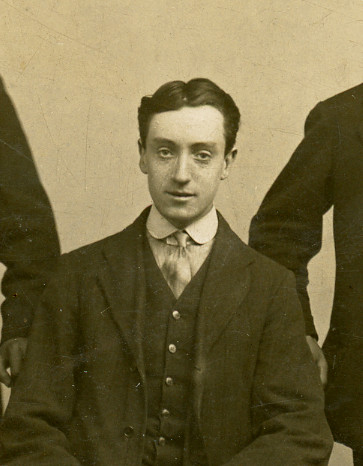Pte
Albert Edward Naldrett
Information about birth
|
Year of birth: 1893 |
|
Place of birth: Marylebone, Middlesex, England, United Kingdom |
General information
|
Last known residence: Ipswich, Suffolk, England, United Kingdom |
|
Profession: Vanman |
Army information
|
Country: England, United Kingdom |
|
Force: British Expeditionary Force |
|
Rank: Private |
|
Service number: 201574 |
|
Enlistment place: London (City), Middlesex, England, United Kingdom |
|
Units: — London Regiment, 2/1st Bn. (Royal Fusiliers) (Last known unit) |
Information about death
|
Date of death: 26/10/1917 |
|
Place of death: Poelcapelle, Belgium |
|
Cause of death: Killed in action (K.I.A.) |
|
Age: 24 |
Memorial
|
Tyne Cot Memorial Panel: 148 |
Distinctions and medals 2
|
British War Medal Medal |
|
Victory Medal Medal |
Points of interest 4
| #1 | Place of birth | ||
| #2 | Last known residence | ||
| #3 | Enlistment place | ||
| #4 | Place of death (approximate) |
My story
Albert Edward Naldrett, a former vanman, was born in 1893 in Marylebone, Middlesex, England. He was the son of James and Margaret Naldrett. In 1911 he worked as a vanman but later worked in Yardley Perfume factory together with his father prior to enlisting. In April 1913 Albert married Ethel Newton and lived in Ipswich, Suffolk, England. He enlisted at Londen, Middlesex, England. Albert Edward served as a Private in the 2/1st Battalion London Regiment, part of the 173rd Brigade, of the 58th Division.
On the opening day of the Second Battle of Passchendaele, 26 October 1917, the 58th Division attacked. The Division was flanked by the 63rd (Naval) Division on its right and the 57th Division on its left. The 58th Division’s advance was carried by the 173rd Brigade, which attacked with the 2/2nd Battalion, the 2/3rd Battalion London Regiment and the 2/4th London Regiment; the 2/1st Battalion remained in reserve. Their orders were to advance from a line, roughly running from Beek Houses to Meunier House and the Brewery, East of the village of Poelkapelle. The attack was to follow the direction of the Poelkapelle-Westrozebeke road, capturing a line some seven hundred yards East of Poelkapelle. The 2/2nd Battalion and the 2/3rd Battalion London Regiment were to capture and consolidate the first objective, after which the 2/4th Battalion was to move through them and capture the final objective.
During the night of the 24th and the 25th of October 1917 the 2/1st Battalion moved up to Poelcappelle and the neighbourhood at 11 AM to act as brigade reserve. A company was stationed at battalion headquarters at Rose Cottage and the three other companies at Pheasant trench. Because of the heavy rainfall during the night the ground was almost impassable. Nevertheless, the attack continued as planned, Zero Hour being 5:40 AM. There was a lot of chaos in information and conflicting reports coming into Bn. HQ. After SOS flag signals were observed C and D company were send forward and formed a defensive line east of Poelcapelle near to the assembly position together with B company. A Company remained at Rose Cottage and helped the wounded coming in. Eventually the division was driven back to its original line.
Albert Edward Naldrett, aged 24, was killed in action on October 26, 1917. Private Naldrett has no known grave and is remembered on panel 148 of the Tyne Cot Memorial.
On the opening day of the Second Battle of Passchendaele, 26 October 1917, the 58th Division attacked. The Division was flanked by the 63rd (Naval) Division on its right and the 57th Division on its left. The 58th Division’s advance was carried by the 173rd Brigade, which attacked with the 2/2nd Battalion, the 2/3rd Battalion London Regiment and the 2/4th London Regiment; the 2/1st Battalion remained in reserve. Their orders were to advance from a line, roughly running from Beek Houses to Meunier House and the Brewery, East of the village of Poelkapelle. The attack was to follow the direction of the Poelkapelle-Westrozebeke road, capturing a line some seven hundred yards East of Poelkapelle. The 2/2nd Battalion and the 2/3rd Battalion London Regiment were to capture and consolidate the first objective, after which the 2/4th Battalion was to move through them and capture the final objective.
During the night of the 24th and the 25th of October 1917 the 2/1st Battalion moved up to Poelcappelle and the neighbourhood at 11 AM to act as brigade reserve. A company was stationed at battalion headquarters at Rose Cottage and the three other companies at Pheasant trench. Because of the heavy rainfall during the night the ground was almost impassable. Nevertheless, the attack continued as planned, Zero Hour being 5:40 AM. There was a lot of chaos in information and conflicting reports coming into Bn. HQ. After SOS flag signals were observed C and D company were send forward and formed a defensive line east of Poelcapelle near to the assembly position together with B company. A Company remained at Rose Cottage and helped the wounded coming in. Eventually the division was driven back to its original line.
Albert Edward Naldrett, aged 24, was killed in action on October 26, 1917. Private Naldrett has no known grave and is remembered on panel 148 of the Tyne Cot Memorial.
Sources 3
|
2/1 Battalion London Regiment (The National Archives, Kew (TNA), WO 95/3001/2) https://www.nationalarchives.gov.uk/ Sources used |
|
Chris McCarthy, Passchendaele: The Day-By-Day Account (Londen: Arms & Armour, 2018), 148. Sources used |
|
Grey W. E., 2nd City of London Regiment (Royal Fusiliers) in the Great War (London: The Headquarters of the Regiment, 1929), 244-249. Sources used |
More information 3
|
Lives of the First World War (Imperial War Museum) https://livesofthefirstworldwar.iwm.org.uk/lifestory/3199784 |
|
Commonwealth War Graves Commission Database https://www.cwgc.org/find-records/find-war-dead/casualty-details/831923 |
|
Namenlijst (In Flanders Fields Museum) https://namenlijst.org/publicsearch/#/person/_id=d694a761-f874-4717-94c2-ea14546aabe8 |
